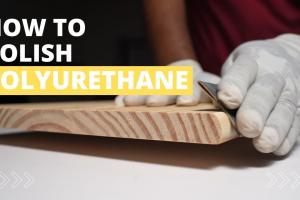Ultimate Guide to Polishing Polyurethane: Tips & Techniques for a Brilliant Finish

-
Quick Links:
- Introduction
- What is Polyurethane?
- Why Polish Polyurethane?
- Preparing to Polish
- Tools and Materials
- Step-by-Step Guide to Polishing Polyurethane
- Expert Tips for Best Results
- Common Mistakes to Avoid
- Case Studies
- FAQs
- Conclusion
Introduction
Polishing polyurethane can transform a dull and lifeless surface into a brilliant, shiny finish that enhances the beauty of woodwork and furniture. Whether you're a seasoned woodworker or a DIY enthusiast, knowing how to properly polish polyurethane is essential for achieving professional results. In this comprehensive guide, we will explore the ins and outs of polishing polyurethane, including the best techniques, tools, and materials needed to get the job done right.
What is Polyurethane?
Polyurethane is a versatile synthetic resin used in a variety of applications, most commonly as a protective finish for wood. It comes in two forms: oil-based and water-based. Oil-based polyurethane offers a rich amber color and a durable finish, while water-based polyurethane dries clear and is easier to clean up. Understanding the characteristics of these finishes is crucial for selecting the right polishing technique.
Why Polish Polyurethane?
Polishing polyurethane serves several purposes:
- Enhances the aesthetic appeal of wood surfaces.
- Removes imperfections and scratches.
- Increases the durability of the finish.
- Prevents moisture and dirt buildup.
By polishing polyurethane, you can ensure your furniture and other wooden items remain beautiful and protected for years to come.
Preparing to Polish
Before diving into the polishing process, preparation is key. Here’s what you need to do:
- Ensure the surface is clean and free of dust and debris.
- Assess the current state of the finish – look for scratches, dull areas, or any inconsistencies.
- Choose the appropriate polishing method based on the type of polyurethane used.
Tools and Materials
Having the right tools and materials on hand will make the polishing process much smoother. Here’s a list of essentials:
- Fine-grit sandpaper (320 to 600 grit)
- Soft cloths or polishing pads
- Polishing compound or rubbing compound
- Buffing machine (optional)
- Vacuum or tack cloth for cleaning
Step-by-Step Guide to Polishing Polyurethane
Step 1: Clean the Surface
Before polishing, make sure to clean the surface thoroughly. Use a vacuum or a tack cloth to remove any dust or dirt.
Step 2: Sand the Surface (if necessary)
If the polyurethane finish has scratches or is uneven, lightly sand the surface with fine-grit sandpaper. Be careful not to sand through the finish.
Step 3: Apply Polishing Compound
Using a soft cloth or polishing pad, apply a small amount of polishing compound to the surface. Work in small sections to ensure even coverage.
Step 4: Buff the Surface
Buff the surface using a clean cloth or a buffing machine. Use circular motions and apply moderate pressure to achieve a high-gloss finish.
Step 5: Inspect and Repeat
Inspect the surface for any remaining imperfections. If necessary, repeat the polishing process until the desired shine is achieved.
Expert Tips for Best Results
- Always test the polishing technique on a small, inconspicuous area first.
- Use high-quality polishing compounds for better results.
- Work in an area with good ventilation to avoid inhaling dust or fumes.
- Consider using a rotary buffer for larger surfaces to save time and effort.
- Regular maintenance can prolong the life of your polyurethane finish.
Common Mistakes to Avoid
- Skipping the cleaning step, which can lead to a cloudy finish.
- Using too much pressure while buffing, which can damage the finish.
- Neglecting to use a clean cloth for the final buffing step.
Case Studies
Case Study 1: Refinishing a Kitchen Table
A homeowner used the steps outlined above to polish an old kitchen table that had lost its shine. After cleaning and lightly sanding, they applied a high-quality polishing compound and achieved a beautiful, glossy finish.
Case Study 2: Restoring Antique Furniture
An antique dealer polished a set of chairs with oil-based polyurethane. After polishing, the chairs not only looked brand new but also regained their protective sheen, making them more appealing to buyers.
FAQs
1. Can I polish polyurethane without sanding?
Yes, if the surface is in good condition, you can polish without sanding.
2. How often should I polish polyurethane?
It depends on usage, but every 6-12 months is generally recommended.
3. What type of polishing compound should I use?
Use a compound specifically designed for polyurethane finishes.
4. Is it safe to polish furniture with kids around?
Always ensure the area is well-ventilated and keep children away from the work area until the polish has dried.
5. What can I do if I accidentally sand through the finish?
You may need to reapply the polyurethane to those areas before polishing again.
6. Can I use a powered sander for polishing?
Yes, but use it cautiously with a fine-grit pad to avoid damaging the finish.
7. Will polishing make my polyurethane last longer?
Yes, polishing can help maintain and extend the lifespan of the finish.
8. What if my finish looks cloudy after polishing?
This could be due to excess polishing compound. Wipe with a clean cloth and buff again.
9. Can I use furniture polish on polyurethane?
It’s best to use products specifically designed for polyurethane finishes.
10. What are signs that I need to polish my polyurethane finish?
Look for dullness, scratches, or signs of wear. If the surface feels rough, it’s time to polish.
Conclusion
Polishing polyurethane is an essential skill for anyone looking to maintain the beauty and longevity of their wooden surfaces. By following the detailed steps and expert tips provided in this guide, you can achieve a stunning finish that enhances the aesthetics of your furniture and other wooden items. Remember, preparation is key, and regular maintenance will keep your polyurethane finishes looking their best for years to come.